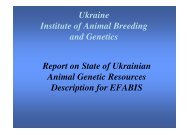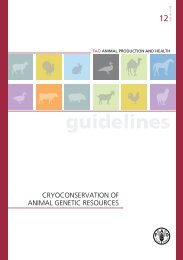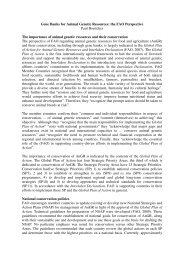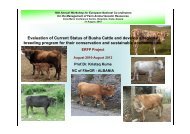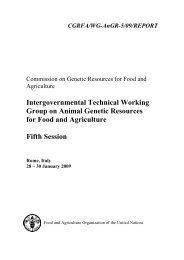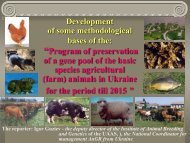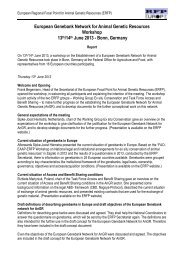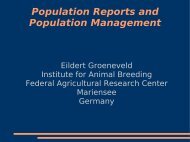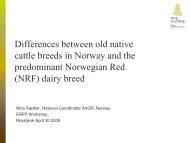The Norwegian Coastal Goat - the Queen of the Alpine Coastal ...
The Norwegian Coastal Goat - the Queen of the Alpine Coastal ...
The Norwegian Coastal Goat - the Queen of the Alpine Coastal ...
- No tags were found...
Create successful ePaper yourself
Turn your PDF publications into a flip-book with our unique Google optimized e-Paper software.
<strong>The</strong> <strong>Norwegian</strong> <strong>Coastal</strong> <strong>Goat</strong>- <strong>the</strong> <strong>Queen</strong> <strong>of</strong> <strong>the</strong> <strong>Alpine</strong> <strong>Coastal</strong>Heaths in NorwaySession 10, abstract no 10318EAAP Annual Meeting 2011, Stavanger, NorwayLinda Stubsjøen & Nina Sæ<strong>the</strong>r*<strong>Norwegian</strong> Genetic Resource CentrePhoto: Brit Hareid
<strong>Coastal</strong> heathlands =Winter grazing + Heath burningPhoto: Brit Hareid
Today“greatlyendangered”(EC HabitatDirective92/43/EEC)<strong>The</strong> atlanticcoastalheathlands -fromPortugal toNorway
Norse sheep grazingcoastal heathlands
<strong>The</strong> home <strong>of</strong> <strong>the</strong> <strong>Coastal</strong> <strong>Goat</strong><strong>Alpine</strong> coastal landscapeN-W <strong>of</strong> NorwayStavanger
<strong>Coastal</strong> heathlands classified in Norway asCultural landscapes <strong>of</strong> special historicaland biological value> Special landscape managementprogramme> Three <strong>Norwegian</strong> Administrative Agenciesare in charge
Traditional farming with coastal goats,<strong>the</strong> flocks:> come home to <strong>the</strong> farm for Christmas.> kidd indoors Jan/Feb> Kids are not let outside <strong>the</strong> first fortnight> <strong>Goat</strong>s stay inside during night to nurse <strong>the</strong> kids> Bucks castrated at young age> leave <strong>the</strong> farm by early spring, grazing outlyingland (coastal heathlands)> come home for short visits during autumn –slaughter animals are selected> main product: four year old castrates
Population data 1995-2010Farm animalsYear <strong>Goat</strong>s Flocks1995 150 15-202010 300 15-20+ 3-4 feral flocks(= appr 150 goats)Ai-bucks:Year Number <strong>of</strong> bucks Semen quality1998 2 Ok2002 3 Ok2007 2 (feral) ☹Photo: Brit Hareid
Challenges in population management,<strong>the</strong> farmed goats Small breeding population Fencing (when grazing infield) Restrictions on crossing regional boarders Home slaughtering prohibited Production, marketing and sale <strong>of</strong> products Difficult to recruit new farmers…☹
Challenges in population management,<strong>the</strong> feral flocks Feral since <strong>the</strong> 1950s Small & closed populations – inbreeding ☹ <strong>Norwegian</strong> Food Safety Authority: “Farm animals must have legal owners!” “This is unacceptable livestock husbandry!” “<strong>The</strong> flocks must be culled!”Photo: Brit Hareid
Opportunities ☺• <strong>The</strong> coastal goats are essential grazers <strong>of</strong>some <strong>of</strong> <strong>the</strong> coastal heath lands in Norway.• <strong>The</strong> three earlier mentioned <strong>Norwegian</strong>Administrative Agencies and regionalauthorities have shown interest in <strong>the</strong>conservation <strong>of</strong> <strong>the</strong> coastal goat.• Conservation <strong>of</strong> <strong>the</strong> coastal goat is in <strong>the</strong>common interest <strong>of</strong> authoritiesconcerned with genetic resources andcultural landscape managementPhoto: Brit Hareid
Way forward – cross sectorial approach• A network <strong>of</strong> representatives from local, regionaland national authorities, societies andassociations will be established.• Initiated by <strong>the</strong> <strong>Norwegian</strong> Genetic ResourceCentre
Thank you!Foto: Brit Hareid




